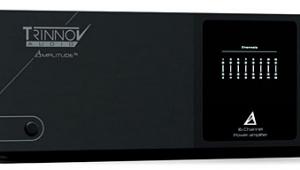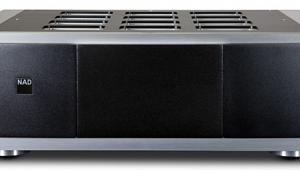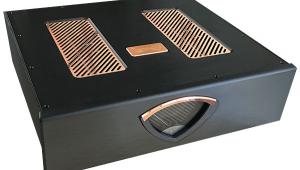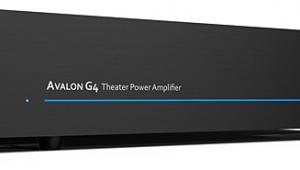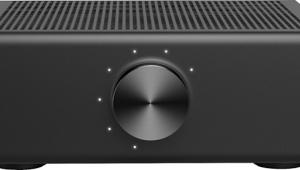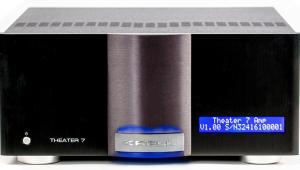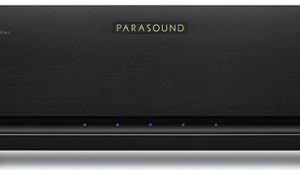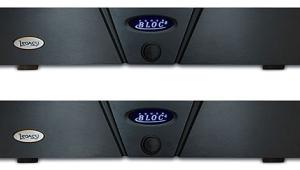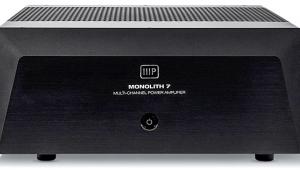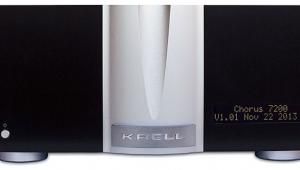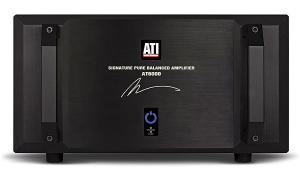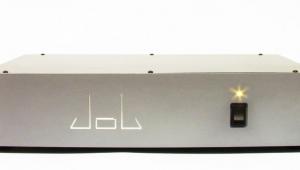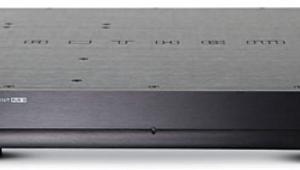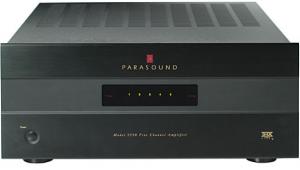Theta Dreadnaught II multichannel power amplifier

Cosmetically identical to the original Dreadnaught, the II includes sonic upgrades, an upgraded power supply providing a small increase in maximum available power, and options that include the ability to equip the amplifier to drive as many as 10 channels. The design provides slots for up to five amplifier plug-in modules. Theta now offers two of these plug-ins for the Dreadnaught II: a high-powered mono module rated at 225W into 8ohms, and a lower-powered, 2-channel module. At 100Wpc into 8ohms, the latter takes up only a single card slot for two channels.
You can use any combination of these modules. Our test sample was equipped for five 225W channels, but we could as easily have ordered three 225W mono modules for the front channels and two mid-powered 2-channel modules to power four surrounds in a 7-channel system. Another possible option would be four high-powered modules to biamp a conventional stereo system. Or you could select five mid-power modules to drive a 10-channel system, biamp all the channels of a 5-channel system, or biamp the three front channels and single-amp four surrounds in a 7-channel setup. The mind boggles. And the Dreadnaught's modular design means the amp's configuration can be easily changed in the field at any time. I didn't test the 100Wpc modules, but I'd be surprised if they weren't based on the technology used for Theta's similarly powered 5-channel, nonmodular Intrepid amp.
Owners of the original Dreadnaught can upgrade their amp with the new modules, with no other change required. But the new amp also has an upgraded power supply with dual toroidal transformers. Putting the new modules in the older amp therefore limits their power output: in the case of the high-power modules, they'll be limited to the original amp's 200Wpc, not the 225Wpc of a completely new Dreadnaught II.
Via a rear-panel selector switch, each channel can be designated as either surround or stereo. Pressing the front-panel Surround button activates all channels. Disengage the button, and only those channels designated as stereo are fully powered; the rest are left in Standby, which mutes those channels and reduces the bias on their output devices to approximately 10% of normal. This feature will appeal to audiophiles, who might assume that it will improve the sound in 2-channel mode. However, even with all channels fully biased but only two actually operating, the power drawn by the silent channels, and any audible degradation that might cause, will likely be minimal. I did all of my auditioning in the Surround setting, even when I was playing 2-channel material.
The Dreadnaught II's basic internal features are much as in the earlier design: no-holds-barred, heavy-duty construction; no global feedback (local feedback around single gain stages only); and a fully balanced differential circuit design. The quality of construction is obvious the minute you unpack the amp—or, rather, try to unpack it. The Dreadnaught is a beautiful but massive design. Don't be fooled by its specified weight of 98 pounds—it feels heavier!
The virtues of no global feedback have always been controversial. Eliminating global feedback generally results in slightly poorer performance on standard bench tests, but proponents of this type of design—Theta included—argue that the timing issues inherent in feeding a portion of the output back to the input result in myriad complex distortions. While these distortions don't register in conventional measurements, the argument goes, they're more destructive to the sound than those eliminated by standard feedback techniques. Designers have disagreed about this for more than 20 years; we're not likely to settle the matter here.
The Dreadnaught II's fully balanced design cancels out internal discontinuities that arise in the course of amplification. Both balanced and single-ended inputs are available for all channels. Single-ended inputs are "cloned" at the input to produce an inverted signal that the amplifier then handles as it would a balanced source.

I did much of my listening to the amp with single-ended inputs; the comments on the sound that follow are applicable to that configuration. Nevertheless, if you have balanced connections, you might get even better performance. I say "might" because in my case the improvement was subtle enough that they could well have been due as much to cable differences as to any inherent advantage in the balanced connection. But keeping that possibility in mind, I did hear a bit more openness and air in balanced mode—a sense of listening deeper into and around the soundstage, or what audiophiles sometimes describe as more black space between the notes. To hammer further on a video analogy, the dynamic contrasts sounded a little more lifelike in balanced operation.
- Log in or register to post comments
